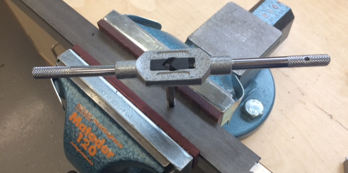
General background and Pre-checks
- Determine which thread size you wish to cut
- Metric threads, M4, M5, M6, M8, M10 & M12 are commonly used.
- M4, for example, means the "standard" M4 thread size: for a bolt, the outside of the thread would be 4mm in diameter, and the spacing between threads (the pitch) would be 0.70mm.
- There are 'non-standard' M4 thread forms, which will have different pitches, which are incompatible with standard M4. For example M4x0.5mm. This would be referred to as "M4 fine", but some people would refer to any M4 pitch less than 0.70mm as M4 fine, so take care!
- Smaller than M4 you readily risk breaking taps in your workpiece (taps are harder than drill bits, so this might mean you've ruined your workpiece).
- There are alternatives threads to metric threads, such as UK imperial threads, the US has a different set of imperial threads, there are special Model Engineer threads, special Cycle threads. Pipe threads are common (though beware, the diameters of pipe threads refer to the internal diameters of the pipe, not the outside diameter of the thread) as are BA (British Association) threads.
- Find out the correct hole size to drill for the thread you wish to tap
- standard metric tapping drill sizes:
- M4 (x0.70mm pitch) - tapping drill 3.3mm
- M5 (x0.80mm pitch) - tapping drill 4.2mm
- M6 (x1.00mm pitch) - tapping drill 5.0mm
- M8 (x1.25mm pitch) - tapping drill 6.8mm
- M10 (x1.50mm pitch) - tapping drill 8.5mm
- M12 (x1.75mm pitch) - tapping drill 10.2mm
- data on other standard metric threads (top table on page)
Step by step (Internal) Threaded Holes (Using a Tap)
- Turn the handle of the wrench to wideren the jaws, fit the threading tap with with single groove to start.
- Use a centre punch mark to centre the drill point.
- Drill a hole smaller than the measure needed for the tap
- Put some Rocol cutting compound on the end of the tap.
- Holding the level and square to the material turn the tap wrench until the first cut into the material has been made.
- Once a grip on the material has been made turn half a turn into the material and then a quarter turn back this will ensure that the tap doesn’t get clogged with the offcuts of material and a better thread is created.
- Keep turning until all the way through the material and most of the way through the thread, there should be no resistance once the cut has been made the full distance through the material when turning in or out using the tap wrench.
- Once through the material using this tap repeat the process using the tap with 2 grooves and then finally again using the tap with no grooves.
- Check the threading using the approparate sized bolt.
Step by step External Threads on Rods (Using a Die)
- Fit the die with the sizing information on the die facing up and the top screw fitting into the slot, making sure all the screws are loose to allow the die to sit flush.
- Tighten up the screw on the die holder to keep the die in place, ensure all the screws fit in the indences in the die.
- Put some Rocol cutting greese on the end of the rod to be threaded,
- Place the rod in a vice square and tighten, use a set square to ensure the rod is square in the vice.
- Place the dice on top of the rod and turn to create the first cut.
- Once a grip on the material has been made turn half a turn into the material and then a quarter turn back this will ensure that the die doesn’t get clogged with the offcuts of material and a better thread is created.
- Keep turning until the depth of thread is achieved, there should be no resistance once the cut has been made level and squre to the rod
- Check the threading using the approparate sized nut.
Download printable version (PDF)- Threading Manual
Addition Thread Data
Data for other thread types is shown below:
- Standard metric thread data (top table on page)
- Non-standard metric tapping drill sizes (2nd table on this page)
The following sources of data are taken from the now discontinued site www.alanstepney.info :
- Alternative metric thread data
- BA (British association) thread data
- Data on various common UK imperial thread sizes
- BSP (British Standard Pipe) thread data
- BSW (British Standard Whitworth) thread data
- BSF (British Standard Whitworth) thread data
- ME (Model Engineer) thread data
- BSB (British Standard Brass) thread data
- BSCy (British Standard Cycle) thread data
- Data on various common US imperial thread sizes
- UNC (Unified National Coarse) thread data
- UNF (Unified National Fine) thread data
- Other US thread data
- Data on unusual/discontinued thread sizes
Link to an external site with details of NPT threads.
RLR20, 23 March 2016
